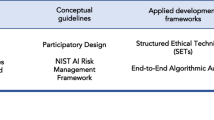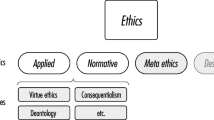Abstract
This paper explores the role of ethics in design. Traditionally, ethical questions have been seen as marginal issues in the design of technology. Part of the reason for this stems from the widely held notion of technology being “out of control.” This notion is a barrier to what I call “ethical design” because it implies that ethics has no role to play in the development of technology. This view, however, is challenged by recent work in the field of Science and Technology Studies (STS). Looking into the dynamics of technological change, STS scholars argue that human choices are present at every stage of a technology’s development and, furthermore, that human values are reflected in the very design of artifacts. This alternative view suggests that ethics can and should be included in the design process. Drawing on examples from the privacy arena. I point to some of the potential advantages of addressing ethical concerns early on in the design of a technology. I conclude with some general strategies for bringing ethics back into design.
Similar content being viewed by others
Notes and references
Winner describes how we have become proficient at assessing the impact of new technologies, but only after they have become ingrained in society: “After the bulldozer has rolled over us, we can pick ourselves up and carefully measure the treadmarks.” Unfortunately, we have been less proficient at keeping “the bulldozer” in check. See Winner, L. (1986) The Whale and the Reactor: A Search for Limits in an Age of High Technology, University of Chicago Press, Chicago, p. 10.
For a somber second reading of the information revolution, see Stoll, C. (1995) Silicon Snake Oil: Second Thoughts on the Information Highway, Doubleday, New York.
Equifax (1995) The 1995 Equifax-Harris mid-decade consumer privacy survey, available at http://www.equifax.com/consumer/parchive/svry95/survy95a.html
The world according to Andy Grove (1994) Business Week: The Information Revolution (Special Issue), 76–78.
Winner, L. (1977) Autonomous Technology: Technics Out-of-Control as a Theme in Political Thought, MIT Press, Cambridge, MA. The term autonomous can be interpreted in a number of ways, from being strongly deterministic (“technology is uncontrollable”) to only mildly so (“technology evolves but we can still influence its development”). In this paper I use autonomous in its stronger sense. For more on ideas of autonomous technology and technological determinism see Smith, M.R. & Marx, L. (eds) (1994) Does Technology Drive History? The Dilemma of Technological Determinism, MIT Press, Cambridge, MA.
Winner, L. (23 November 1997) How technomania is overtaking the millennium. Newsday, B6.
Technology makes us better (editorial) (28 September 1997) New York Times Magazine, 45; Toffler, A. (1991) Powershift: Knowledge, Wealth, and Violence at the Edge of the 21st Century, Bantam Books, New York.
Marsh, A. (22 September 1997) No place to hide. Forbes, 226; Taylor and Jerome (October 1997) We know where you live. PC Computing, 91.
Johnson, D. (September 1997) Is the global information infrastructure a democratic technology? Computers and Society, 20–26.
See, for example, CYBERsitter: where do we not want you to go today? at the Peacefire web site: http://www.peacefire.org/censorware/CYBERsitter
Lessig, L. (1999) Code: And Other Laws of Cyberspace, Basic Books, New York.
Sarewitz, D. (1996) Frontiers of Illusion: Science, Technology, and the Politics of Progress, Temple University Press, Philadelphia, p. 142.
See, e.g., Meeks, B.N. (1997) “Better democracy through technology,” Communications of the ACM 40,2: 75–78; Grossman, L. K. (1995) The electronic republic: Reshaping democracy in the information age. Penguin Books, New York.
Bijker, W.E., Hughes, T.P. & Pinch, T. (eds) (1987) The Social Construction of Technological Systems, MIT Press, Cambridge, MA.
Van Lente, H. and Rip, A. (1999) Expectations in technological developments: An example of prospective structures to be filled in by agency, in: Disco, C. and van der Meulen, B. (eds.) Getting new technologies together: Studies in making sociotechnical order, Walter de Gruyter, Berlin, pp. 203–229.
Pinch, T.J. & Bijker, W.E. (1987) The Social Construction of Facts and Artifacts: Or How the Sociology of Science and the Sociology of Technology Might Benefit Each Other, in: Bijker et al. (eds) (1987)15,. pp. 17–50.
David, P.A. (1985) Clio and the economics of QWERTY. American Economic Review 72, 2: 332–337; Hughes, T.P. (1987) The Evolution of Large Technological Systems, in: Bijker et al. (eds) (1987),15 pp. 51–82.
Dowie, M. (September/October 1977) Pinto madness. Mother Jones, 18–32.
Hibbert, C. (1999) Some frequently asked questions on SSNs, available at http://www.cpsr.org/cpsr/privacy/ssn/ssn.faq.html; Regan, P. (1995) Legislating Privacy: Technology, Social Values, and Public Policy, University of North Carolina Press, Chapel Hill.
I found only one newspaper article that reported on privacy issues related to highway 407 during the period of its construction; see Gooderham, M. (18 March 1995) Privacy at risk in toll systems, drivers told. The Globe and Mail, A4.
Bloomfield, B.P. & Vurdubakis, T. (1997) Boundary disputes: negotiating the boundary between the technical and the social in the development of IT systems. Information Technology & People 7/1: 9–24; Star, S.L. (ed) (1995) Ecologies of Knowledge: Work and Politics in Science and Technology, SUNY Press, Albany, NY.
Schuler, D. & Namioka, A. (eds) (1993) Participatory Design: Principles and Practices, Lawrence Erlbaum Associates, Hillsdale, NJ, p. xi.
Greenbaum, J. & Kyng, M. (1991) Design at Work: Cooperative Design of Computer Systems, Lawrence Erlbaum Associates, Hillsdale, NJ.
See Sclove, R.E. (1995) Democracy and Technology, Guilford Press, New York. The STS department at Rensselaer has launched a number of educational initiatives to bring values explicitly into the design of technology; see, for example, the new Product, Design, and Innovation undergraduate program at http://www.rpi.edu/dept/sts/pdi/index.html
Author information
Authors and Affiliations
Additional information
Patrick Feng is a Ph.D. student in the Science and Technology Studies Department at Rensselaer. His research focuses on the development of technical standards that are designed to address social values such as privacy and trust.
Rights and permissions
About this article
Cite this article
Feng, P. Rethinking technology, revitalizing ethics: Overcoming barriers to ethical design. SCI ENG ETHICS 6, 207–220 (2000). https://doi.org/10.1007/s11948-000-0049-4
Received:
Revised:
Accepted:
Issue Date:
DOI: https://doi.org/10.1007/s11948-000-0049-4




